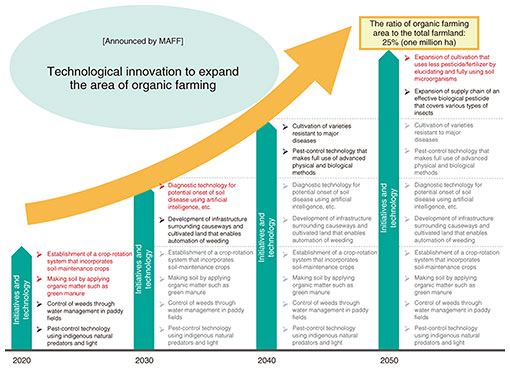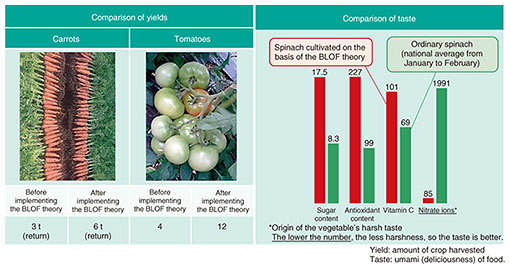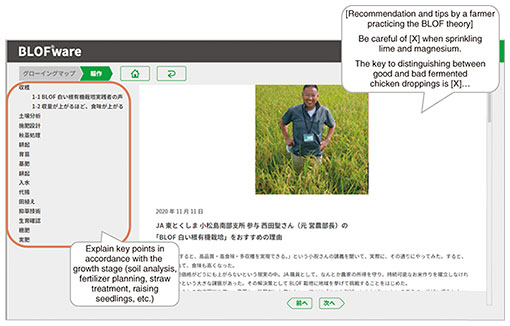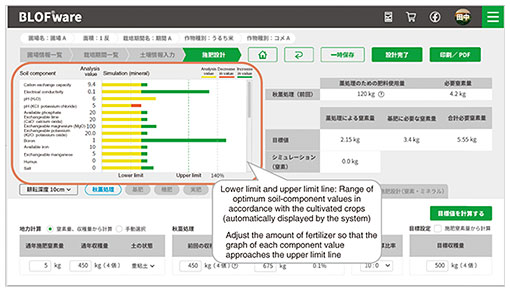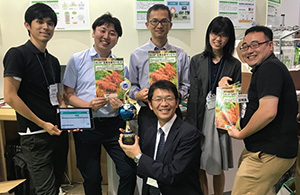 |
|||||||||||||
|
|
|||||||||||||
|
Feature Articles: Initiatives for Smart Agri—Making Japanese Agriculture a Growing Industry Vol. 19, No. 8, pp. 31–36, Aug. 2021. https://doi.org/10.53829/ntr202108fa5 High-quality, High-yield Organic Farming with BLOFware®.DoctorAbstractOrganic farming has been gaining attention as a sustainable agriculture both in Japan and around the world; however, it faces problems such as inconsistent quality and yield, making stabilized production difficult. The organic cultivation theory called the “BLOF® (biological farming) theory” can solve these problems and achieve stable, high-quality, high-yield production in organic farming. NTT COMWARE has incorporated the expertise of organic cultivation based on the BLOF theory into its service system and started to provide a cloud-based farming-support service called “BLOFware®.Doctor.” The service content and future development of BLOFware.Doctor are introduced in this article. Keywords: smart agriculture, organic farming, BLOFware® 1. Environment surrounding organic farmingAccompanying the widespread adoption of the United Nations’ Sustainable Development Goals, interest in organic farming as a sustainable agriculture to conserve the global environment has been growing around the world. Organic farming is also being actively promoted in Japan, where the Ministry of Agriculture, Forestry and Fisheries (MAFF) has set a goal of increasing the area of organic farming to 25% (one million ha) of Japan’s total farmland by 2050 [1, 2] (Fig. 1). However, the current area of organic farming as a percentage of total farmland is only 0.5% (237,000 ha, as of 2018) [3], therefore, increasing it to 25% in about 30 years is a very challenging goal. Organic farming generally requires more labor than conventional agriculture,*1 and its quality and yield are inconsistent, so it is difficult to stabilize production. To achieve the above-mentioned goal, it is important to establish and disseminate effective technologies to solve these problems facing organic farming.
2. Applying the BLOF® theory to solve the problems facing organic farmingThe solution to the above problems facing organic farming is the “BLOF® (biological farming) theory,”*2 which is an organic-cultivation theory advocated by Masaaki Koiwai of Japan Bio Farm Co., Ltd. The BLOF theory enables stable production of organic crops with high quality and high yield by scientifically and logically preparing the soil (Fig. 2). To create optimal soil for growing crops, it is necessary to create ideal conditions with respect to the following three major soil components: (i) amino acids, which build cells; (ii) minerals, which are essential for maintaining life; and (iii) medium-matured compost, which promotes root growth.
Plants produce amino acids (organic nitrogen) necessary for growth by synthesizing carbohydrates created through photosynthesis and inorganic nitrogen absorbed from the roots; however, research has shown that amino acids can be absorbed directly through the roots. The BLOF theory applies the results of this research and enables the provision of amino acids as fertilizer to be absorbed directly by the roots to achieve higher quality and higher yields than ordinary crops. Minerals in the soil that have been consumed by crops in large quantities to promote high quality and high yield can be appropriately replenished through fertilization*3 on the basis of the results of analyzing the current compositional balance of the soil; as a result, stable production is possible in the following years. By using medium-matured compost, it is possible to create soil with a fluffy, clustered structure. This type of soil allows the roots to grow deep into the ground, producing strong crops that do not attract pests and diseases without the use of pesticides. The BLOF theory, which provides solutions to the problems facing organic farming and helps expand the area of organic farming, is evolving yearly. However, because it requires a high degree of specialized knowledge and skills to put it into practice, it has not been widely used.
3. Cloud-based farming-support service: BLOFware®.DoctorIn August 2020, through a business alliance with Japan Bio Farm, NTT COMWARE started providing the cloud-based farming-support service called BLOFware®.Doctor that incorporates the knowledge of the BLOF theory. During the development of BLOFware.Doctor, we adopted an agile methodology and worked with Japan Bio Farm from the concept-making stage. We conducted interviews with experts in the BLOF theory and farmers about a prototype of BLOFware.Doctor and flexibly reflected the issues and requests we obtained from them in the specifications of the prototype. In this manner, we continued improving the prototype. In August 2019, we conducted demonstration tests on organic farming based on the BLOF theory by using the prototype of BLOFware.Doctor in cooperation with farmers and confirmed that BLOFware.Doctor can contribute to implementing organic farming based on the BLOF theory. After incorporating the requests from farmers concerning operability and functionality received during the demonstration tests, we launched the service on a full scale in August 2020. We are collaborating with Japan Bio Farm regarding the provision as well as development of BLOFware.Doctor. By dividing the roles of the two companies according to their strengths, that is, NTT COMWARE took responsibility for construction and provision of the service system, while Japan Bio Farm took responsibility for provision of expertise and knowledge concerning the BLOF theory and user guidance, we are able to provide services that focus on helping farmers. BLOFware.Doctor allows farmers who have never been exposed to the BLOF theory to easily practice organic farming based on the BLOF theory on the basis of the following three points. 3.1 Point 1: The BLOF theory can be learnt from the basicsThe first point is that it has a full range of features to help users learn the basics of the BLOF theory. BLOFware.Doctor provides a “growing map” that explains the basics of the BLOF theory in an easy-to-understand manner with photos (Fig. 3). The map can serve as a textbook of the BLOF theory that summarizes key points concerning work to be done in accordance with the growth stage of each crop, and it can be used for learning the BLOF theory and as a manual guide for actual farm work.
Japan Bio Farm also holds regular online seminars limited to users of BLOFware.Doctor. This is a special program that includes lectures on how to use BLOFware.Doctor and guidance on the agricultural work needed at that time of the year, so users can immediately put into practice what they learned in the seminar. The growing map is available (via the cloud) for reference any time, and the seminars are archived for review at any time, so users can learn whenever they like, such as during their spare time. At organizations with multiple farmers, such as agricultural corporations, members can learn the same content, even if it is difficult for everyone to get together at the same time, which helps to establish a common language. 3.2 Point 2: Anyone can easily practice soil analysis and fertilizer planningThe second point is that soil analysis and fertilizer planning can be easily carried out by anyone. The two most-important steps in soil preparation, which is the core of the BLOF theory, are soil analysis, which analyzes the balance of soil components in the field in question, and fertilizer planning, which calculates how much fertilizer should be applied to the field. If these steps are not done properly, the effectiveness of practicing the BLOF theory will be greatly reduced. BLOFware.Doctor is linked with the soil-analysis service provided by Japan Bio Farm. Users collect soil from their fields and send it to Japan Bio Farm, who analyze it and send the analysis results back to the users. The received analysis data can be easily imported into BLOFware.Doctor, so users can immediately proceed to creating a fertilizer plan. Although Excel tools are available to assist in fertilizer planning for the BLOF theory, they require complex calculations and adjustments, which is one of the reasons that beginners stumble when practicing the BLOF theory. In response to the feedback from farmers, BLOFware.Doctor was designed so that anyone can easily create fertilizer plans by using graphs and easy-to-understand operations. Users can simulate the optimal amount of fertilizer by simply adjusting the amount of fertilizer they want to use in accordance with a guidance for optimal balance of soil components that is automatically displayed on their screen (Fig. 4). The calculation and adjustment logic is all built into the service system, so the user does not need to be aware of it. By applying fertilizer in accordance with the resulting fertilizer plan, it is possible to create the optimal soil for growing certain crops and achieve high-quality, high-yield production.
BLOFware.Doctor incorporates new knowledge on nitrogen content in the soil, whereas the only previously published information on fertilizer planning was related to the balance of mineral components. By simply entering the required information, the system automatically calculates the optimal amount of nitrogen and the amount of fertilizer needed to achieve it. BLOFware.Doctor also incorporates a large amount of information that has never been made public before. For example, BLOFware.Doctor not only has separate functions for rice, vegetables, and fruit crops but also incorporates optimized calculation logic for each crop, such as carrots, onions, and spinach; in contrast, only common calculation logic for all crops was previously published. This information is unique to Japan Bio Farm and has not been published previously. Incorporating this information into BLOFware.Doctor makes it possible for a wide range of farmers to use advanced technology based on the BLOF theory while the core information is kept secret. 3.3 Point 3: Support is available when problems ariseThe third point is that support is available whenever the user needs it. Although there are about 2000 practitioners of the BLOF theory, they are scattered throughout Japan. Consequently, it is often the case that newcomers to the BLOF theory have no one around them who practices it or no other practitioners to turn to for advice when in need. To address this issue, BLOFware.Doctor provides a support function, called “instructor’s advice,” which allows users to seek advice from instructors who are experts in the BLOF theory (Fig. 5). First, the user inputs questions and photographs of actual crops. The instructor returns advice based on the questions and photographs as well as information such as the results of soil analysis and a fertilizer plan for the user’s fields. Therefore, the user can receive suitable advice based on his/her specific situation—just like a family doctor.
We have also set up a Facebook page exclusively for BLOFware.Doctor users as a platform to exchange information with other practitioners. That page will allow users to interact with each other and accumulate more knowledge. 4. Future developmentsBy providing BLOFware.Doctor featuring the three key points described above, we will help farmers succeed through the practice of the BLOF theory. Currently, only the rice-paddy version is available, but the vegetable and fruit-tree versions will be respectively available in the summer and fall of 2021. We plan to make BLOFware.Doctor even easier to use by incorporating the voices of farmers and the latest knowledge about the BLOF theory and improving the instructor-advice function with artificial intelligence and chatbots. We also want to develop BLOFware.Doctor into a BLOFware series of services that provides comprehensive support for agriculture—from production to sales—to help farmers increase profits. In the future, we will consider global expansion of BLOFware.Doctor to contribute to solving the world’s food crisis. References
Authors: (back row from left) Shintaro Uno, Manager, NTT COMWARE CORPORATION; Yutaka Kobayashi, Chief, NTT COMWARE CORPORATION; Takeshi Saito, Chief, NTT COMWARE CORPORATION; Marina Wada, Member, NTT COMWARE CORPORATION; Masashi Kashima, Chief, NTT COMWARE CORPORATION; (front row center) Hirofumi Umeshita, General Manager, NTT COMWARE CORPORATION |
|||||||||||||









